MiGs, Stars & Magic Books: A Brief History of Trespassing in Moscow
An illustrated guide to urban exploration in the Russian capital.

18 February 2014
Built for a population in excess of a million – yet largely uninhabited to this day – it’s little surprise that Ordos has earned itself the nickname of China’s Ghost City.
In this report I’ll be looking up-close at the Kangbashi New Area, the most recent addition to the city of Ordos; and by far its least populous district. Rather than photograph these buildings from afar though, when I visited Ordos in 2013 my plan was to get under the skin of this bizarre metropolis, examining it from inside, above and below.


In my recent post titled “Welcome to Ordos“, I gave something of an introduction to the Ghost City – the region and its culture, China’s swelling property market and the stillborn future metropolis of Ordos. I documented the old centre of Ordos (a run-down mess of unfinished apartments, office blocks, casinos, car parks and brothels), the most densely populated district of the city. I also introduced the Kangbashi New Area: taking a walk around the stylish, modern and utterly deserted Genghis Khan Square, right in the heart of Kangbashi.
By this point though, the walking tour was over, and it was time to see the real Ordos – to see what the BBC, Al Jazeera, the New York Times et al., had, in my opinion, failed to show. It was time to get off the approved footpaths, to start opening some doors and ignoring no entry signs, as we attempted to infiltrate the world’s largest ghost town.
From Genghis Khan Square we turned east, crossing a patch of scrubland that I can only guess had been intended to some day burst into green grass. Soon a long, square building rose up to our right, decorated with complex ridges and textured beams along its hull. We figured it for a supermarket – though from the outside there were few clues as to what the building might contain… if it even contained anything.

Along this main road, a steady trickle of vehicles passed us on their way towards Dongsheng and its airport in the east. We needed to get away from the cars though, get out into the forest of unfinished towers, the shells of apartment buildings that rose out of the sand like dead trees in a drought.
Turning away from the road, weaving this way and that onto the smaller, narrower backstreets, we found our way into a residential estate. The buildings were linked here by a series of winding footpaths, the roads diverted around the block to leave a pedestrianised space at its heart. Paving stones formed a track through the shifting sand, looping from one building to the next amidst towering stacks of plastic-wrapped outdoor furniture; unassembled amenities piled in every corner, as if freshly tipped from the back of a lorry.
Turning the corner into a courtyard between tall, concrete towers, we passed a capsized statue: a modern, stylised figure of a mother and child, lain forgotten behind a stack of building materials.

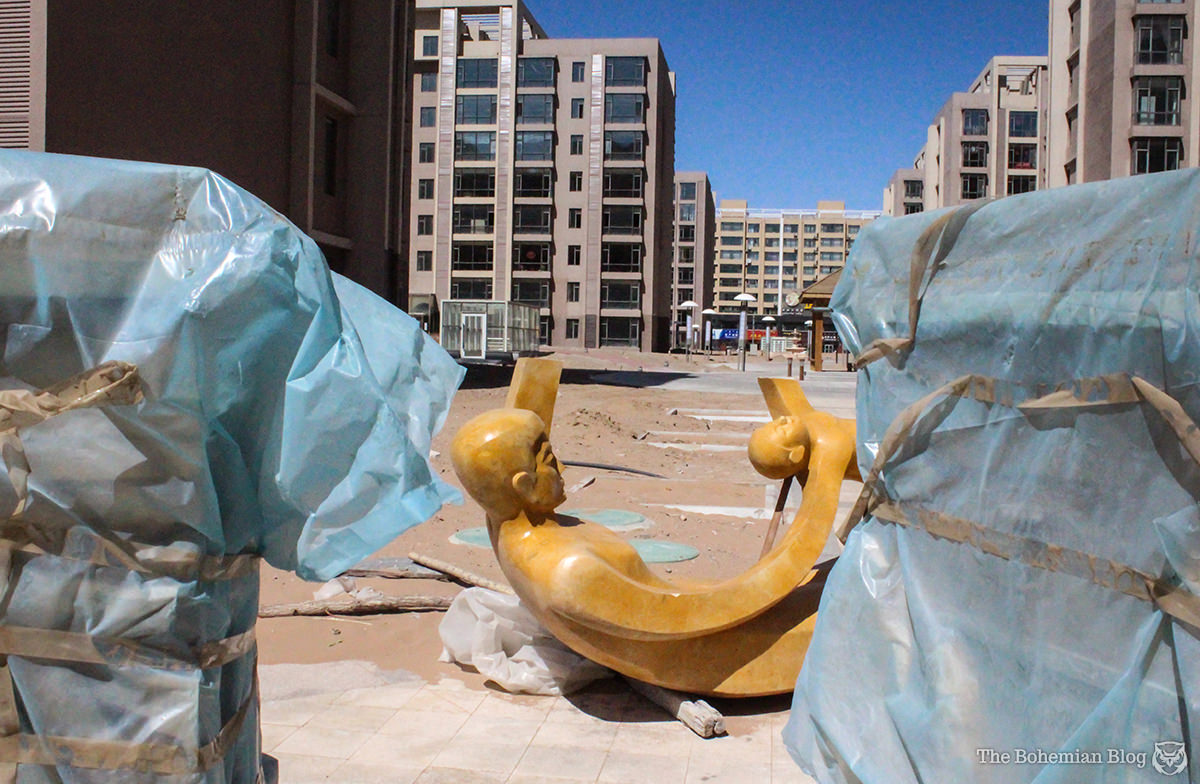
It was clear how the small square had been envisaged, as comfortable, high-rise apartments facing in towards a communal garden area. Perhaps it would have featured flowers, fountains and benches when complete – perhaps it still will, some day. Impossible to tell.
Here and there between the buildings, the occasional glass-panelled box rose up out of the ground; each one of them featuring an elevator shaft or a flight of stairs heading downwards. Soon enough we found a lift shaft with a broken glass panel at the rear, and, squeezing through the gap we made our way swiftly down into the bowels of Kangbashi.
Beneath the street plan, a whole lower level of the city seemed to have been set aside for parking. It made sense, keeping the cars away from these residential zones by redirecting traffic underground instead. More and more we’d see just how much thought and planning had gone into the Kangbashi New Area.
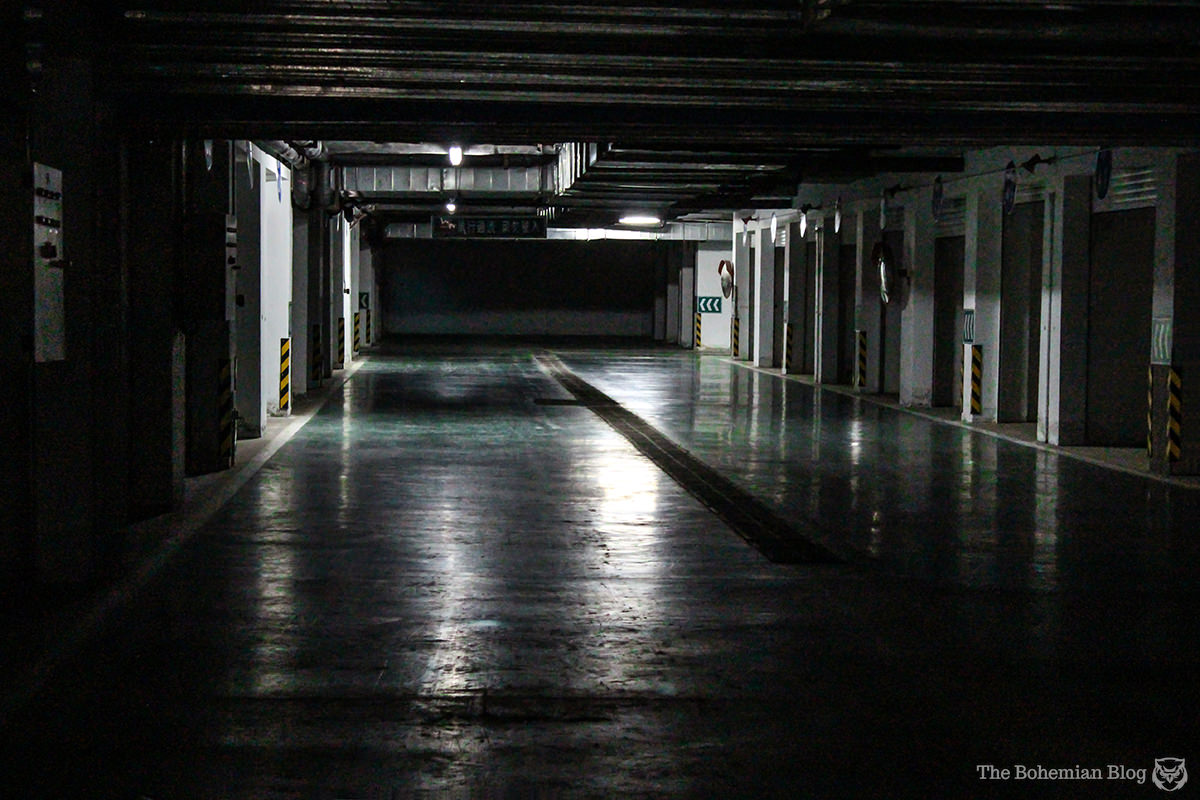
The lights came on as we entered, and the long, wide tunnel ahead shone in shades of silver and green. There were two, maybe three parked cars in sight – and expensive looking ones at that. Despite these few lonely residents however, the whole place still had that freshly varnished look about it: not a footprint nor a tyre mark in sight.
Here and there along the tunnels, between the series of subterranean parking halls that fed one into another through a network of identical bulkhead doors, we’d see elevators leading back up towards the surface. I tried one – the lights fired up immediately, and we rode a lift right up into the building above.
If you’re imagining a carpeted, stainless steel elevator, perhaps even fitted with a mirror, then you’d be wrong. This lift was little more than a plywood cage, a terrifying, creaking box that seemed to wobble as it rose… as if hoisted up by a rope slung over the branch of a tree.

First we had a look around the ground floor of the building; bare concrete for the most part, though all the lights came on at a touch. In the corner of a corridor, a massive fuse box was set into one raw, unplastered wall. I popped it open, the creaking cover unlocked, to reveal a vast array of crude solder joins and trailing, loose wires. I quickly snapped the lid closed again with the back of my hand.
Then, plucking up the courage, I knocked on the door of an apartment. No answer. I waited a while, knocked again, then slowly turned the handle. The door opened freely, and we took a look inside – at the dusty unfinished floors, the bare gypsum walls that formed the basic foundations of what had the potential to be a spacious family flat. In the largest room, beneath the window, a children’s table and chairs had been arranged, set with plastic cups and bowls and chopsticks.
We tried a couple more homes – all of them the same – before making our way up to the highest level. Stepping out of the lift onto the 12th floor corridor, I found myself instinctively tiptoeing… as if sneaking past the occupants of a normal, busy building. Of course, the chances of anyone being home were next to zero; but then, the cars parked down below had presumably belonged to someone.
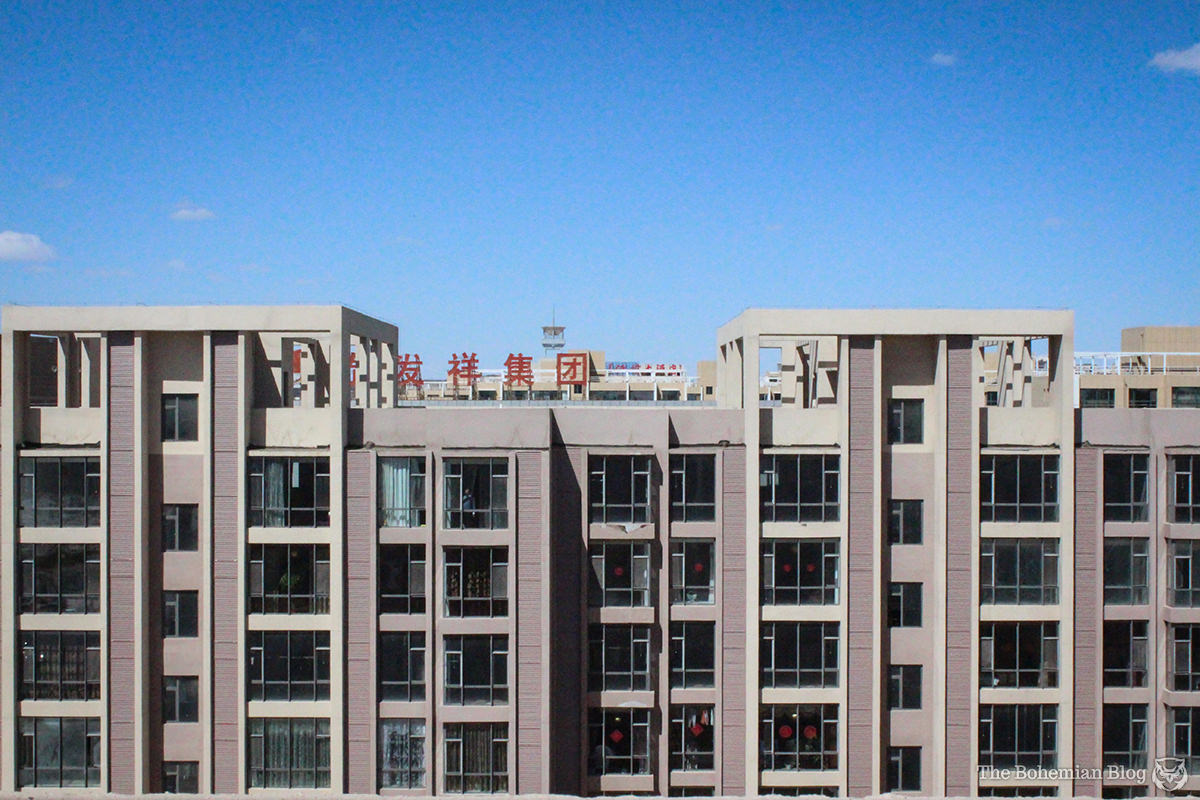
At the end of the corridor, around the corner, a flight of steps went upwards to a simple wooden door. It seemed too large to fit its frame, and so rather than being locked the exit was fastened tight with wire; a long tangle of stiff cable had been twisted around the door handle, looped about a stair rail and then tied up into a sharp and prickly mess. It took a few minutes of bending, twisting and bloody fingers before we were finally stepping out onto the roof of the apartment building.
Up until this point we’d been sheltered; contemplating only one empty street after another. From this height though, we finally started to get a sense of scale. Row after row after row of towers spread out around us, many of them no more than skeletons attended by rusty cranes. I began to realise for the first time quite how large this city was supposed to have been.
As good as the view was though, we were still shielded on all sides by taller builders. What we saw of the cityscape – the desert beyond – came to us in glimpses between the looming concrete shapes pressed in on all sides. I wanted to get higher still, to escape above the horizon and look down on the ghost city as a whole.
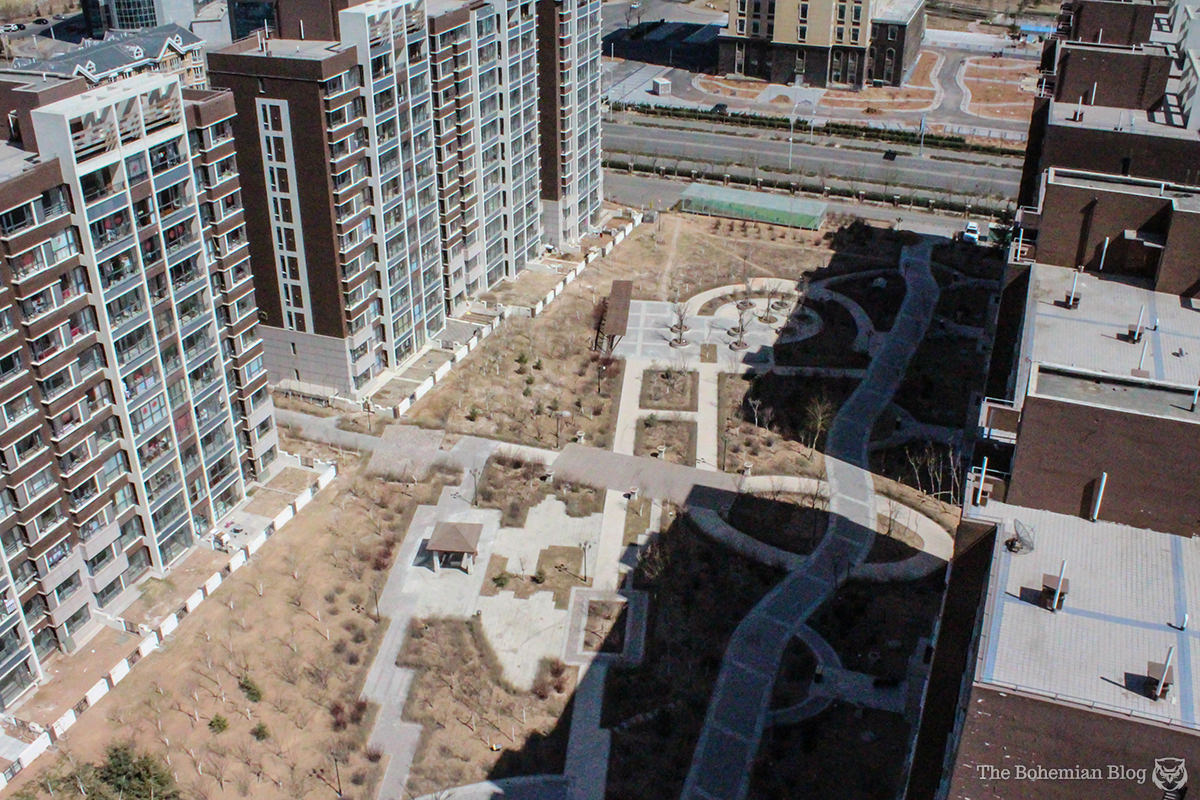
But for that, we were going to need a bigger building.
Heading back down to street level, we wandered for a while through the estates. Residential towers rose up around a series of consecutive dirt bowls, each one of them sown with the seeds of utopia, each one of them a doomed and withered crop. Reaching the end of the zone we hopped a fence and crossed the road; I guess by now we were heading northeast.

We walked along a main street, hemmed in on all sides by shops, apartment blocks, colourful school buildings and the vast bulk of Kangbashi Hospital. The occasional car or bike hummed past, but the pavements around us were empty save for the occasional crew of street sweepers. Even now, it was hard to get one’s head around the idea that all of this was uninhabited.
On our right, we passed a police station. It met the typical Chinese design: a square, officious building set back behind a courtyard, a sentry box watching over the folding fence out front. It seemed hard to believe that even this station was unoccupied.
I didn’t know which way to turn next, so consumed as I was with a desire to explore everything. Marching headlong into the police station seemed a leap too far, however… so we tried the hospital instead.
It was impossible to tell whether the building had seen use, or whether, like so much of the city, it had so far only welcomed the boots of construction crews. We decided to put it to the test.

Approaching the side of the hospital building we tried a small door, found it open, and ducked beneath the curtain that hung across within. Before us a narrow, grotty staircase led down several levels under the ground. We strolled on in, beneath electric lights that burned for no one, onwards and downwards to who knew what.
We never did find out. A babble of shouted words tumbled down the staircase behind us, hot from the mouth of an angry security guard. We tried reasoning with him – “just a few photos, yeah?” – but it clearly wasn’t going to happen.
After being frogmarched back to the street by a man who could have passed as a Triad tough-guy in any Hollywood thriller, we crossed over the road, and made a beeline for our next target.
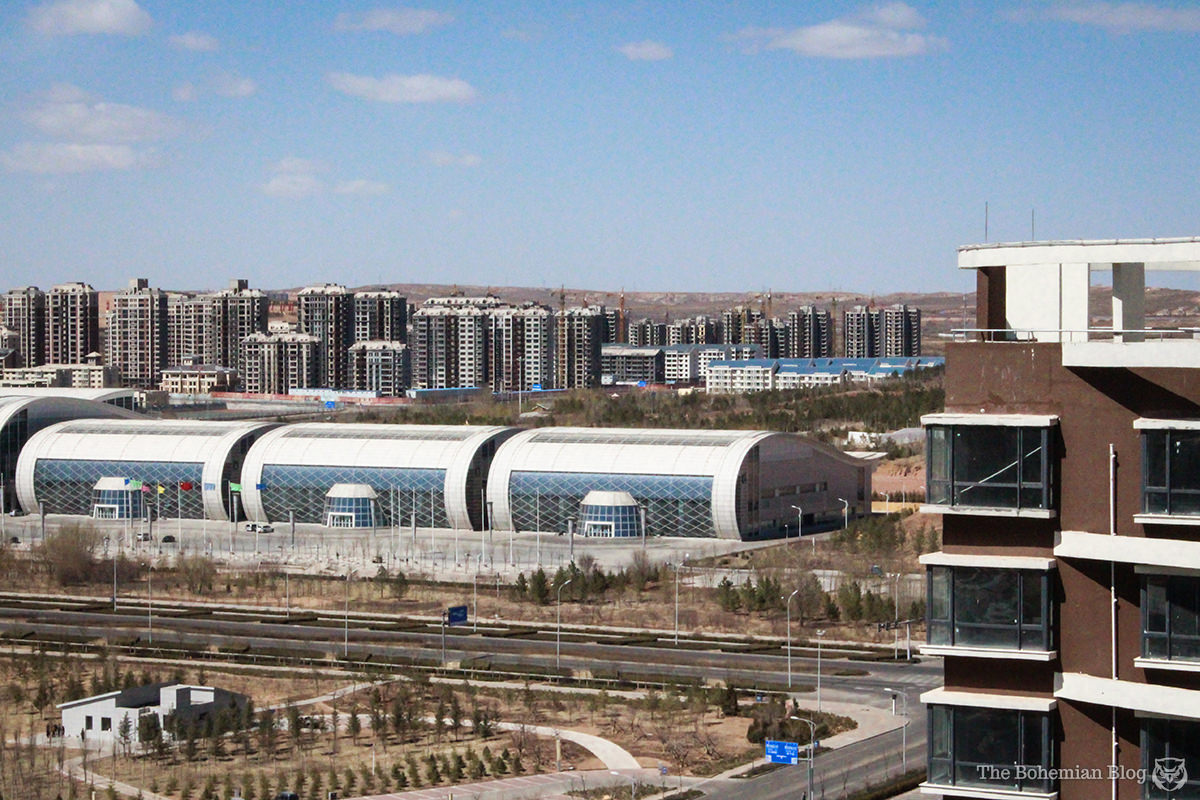
One of the signs on the building opposite said something about solicitors, though this concrete shell fell a long way short of a functioning office. The ground level was boarded up, but there was a small hole punched through the thin wooden veneer – so I ducked on through and slipped inside the building.
It was silent inside, a still, dusty space that could well have grown into a shopping centre in time. This first room fed through a doorway into a larger space beyond, and I swung around the corner almost headlong into a work crew. In true Chinese style, two men operated heavy tools while another five smoked and watched them. One of them looked up, caught my eye: I smiled back warmly, then backed out fast the way I had come.
By now we’d walked a fair distance from our last rooftop, and the towers now surrounding us rose significantly higher than the last batch – a good 20-or-so storeys. We decided to give it another go and so we nipped across the forecourt of a bare, plastic-fronted kindergarten, and into another residential estate.
 There were roads between the buildings this time, a couple of cars parked on corners and even one in motion; its occupants eyeing us warily as they cruised on by. We made for one of the closest towers before trying the door, finding it open, and letting ourselves in.
There were roads between the buildings this time, a couple of cars parked on corners and even one in motion; its occupants eyeing us warily as they cruised on by. We made for one of the closest towers before trying the door, finding it open, and letting ourselves in.
This building was in a much better state than the last apartment block. The walls were finished, and several doors were decorated with the Chinese symbols for luck and fortune. We made straight for the lift and rode it to the top.
Upstairs, an open door led into a lavish apartment hung with chandeliers and textured wallpaper; an opulent penthouse suite. There were sounds of activity inside and so we crept past quickly, before taking the last flight of steps up to the roof. The door opened at a push, and we stepped out into the sky.
This rooftop was smaller than the last – just a square, open space, and a second door that opened onto the whirring, rusted mechanism that powered the lift. If the view from the top of the other block had been impressive though, this one was spectacular.
Ordos fell away beneath us: a wide, sweeping wasteland of empty towers and silent, disused streets. I tried looking out for signs of motion, clues to life in the metropolis. The odd car moved slowly along the main road, where it looped around the centre of Kangbashi to cross the Ordos bridge, and out towards Dongsheng – but for the most part, from this height, Kangbashi looked like a model city; its radical architecture reduced to novelty ornaments, its unfinished towers scattered like broken bricks across a sandpit.
Perhaps the biggest problem that presented itself now, was deciding on our next destination. We looked about us, turning in 360 degrees to take in the bridge, the high-rises, the city centre at Genghis Khan Square, the futuristic exhibition centre, the would-be residential estates fading off row after row into the desert… and then our eyes fell across the newly-built Kangbashi sports centre.


The green pitch seemed to glow through the heat haze, the brightly coloured seating unfolding around it like the petals of a strange desert orchid. We made a mental note of the direction, of the landmarks that would lead us – street by street – to the city’s sports ground; and then we made our way back down to the street.
Coming out of the estate and back onto the main road, at first we retraced our footsteps; back past the hospital, the building sites and the police station, back in the direction of the colourful sports grounds.
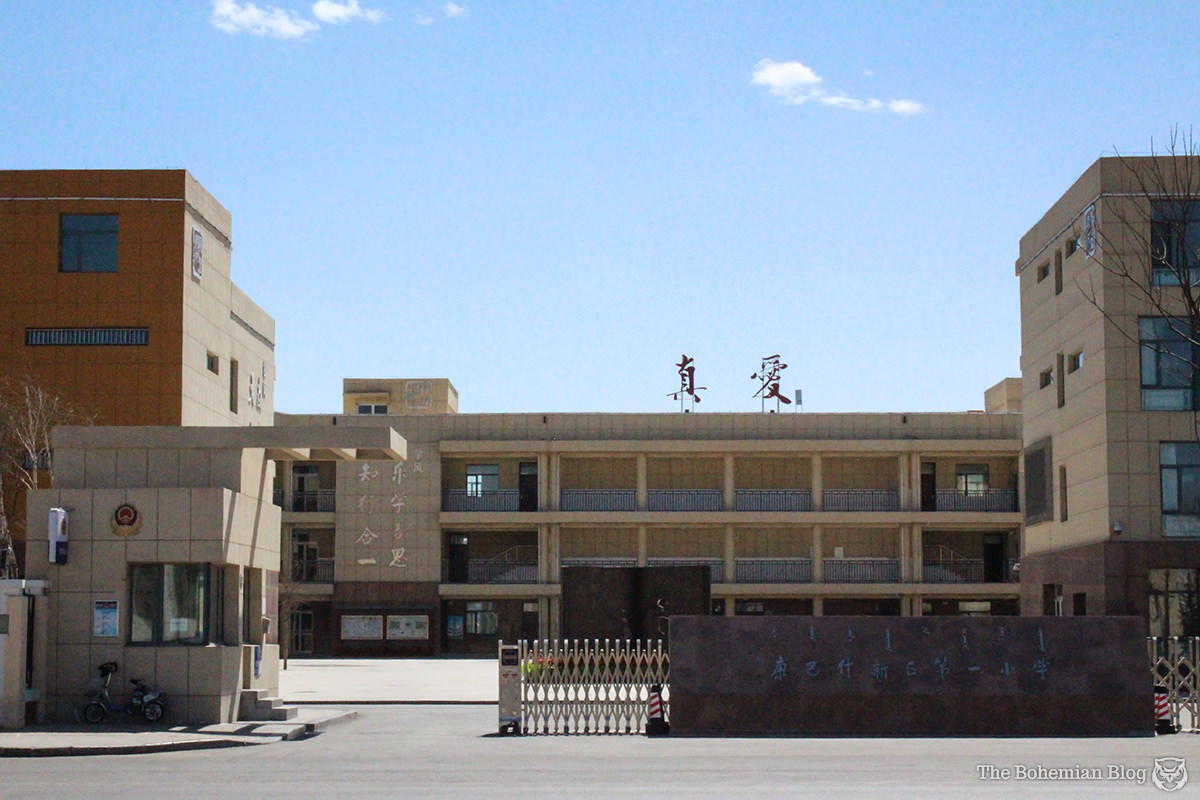
When we’d passed the police station earlier, we had still been courting disbelief – trying in vain to process the desolation, the utter emptiness of Kangbashi. It simply hadn’t seemed possible. Besides, a lifetime’s worth of social programming had told me not to attempt to trespass on what might turn out to be a live police station.
By now though, we’d passed through the stage of tentative disbelief, and into one of absolute freedom – the slow-dawning realisation that virtually everything in Kangbashi was open to be explored. So, crossing the road to the open gates, we checked the empty street around us before stepping over the threshold into the police station’s forecourt. It was just as empty as we’d expected, not a car nor an officer in sight.
We were just ambling across to the main building, when a voice behind us called out something in Chinese. At first, we instinctively guessed we’d been caught… but as it turned out the voice belonged to a caretaker. More than anything else, the man was simply surprised to see foreign faces here in Ordos.

 My companion spoke reasonable Chinese, and so we were able to have a conversation with the man. He told us he was part of the maintenance crew, and offered to give us a tour of the place. It seemed like the novelty of showing visitors around his little corner of the Ghost City was just too exciting an experience to pass up. We walked, and our new friend took great pleasure in pointing out the elaborate features around us – while explaining how much each one had cost to install.
My companion spoke reasonable Chinese, and so we were able to have a conversation with the man. He told us he was part of the maintenance crew, and offered to give us a tour of the place. It seemed like the novelty of showing visitors around his little corner of the Ghost City was just too exciting an experience to pass up. We walked, and our new friend took great pleasure in pointing out the elaborate features around us – while explaining how much each one had cost to install.
“Four thousand Quai!” he said, laughing at a large ceramic pot inlaid with traditional Mongolian figures. That’s about £400.
It was clear that this man saw Kangbashi as one colossal folly. He would quote prices, then wave his arms about at the empty streets, his gestures doing much to communicate the madness of such grandiose investment in a ghost town. We followed him through the station compound, past glass panes that opened onto empty offices; between the virgin buildings and through to the rear, where the police station backed onto a school.
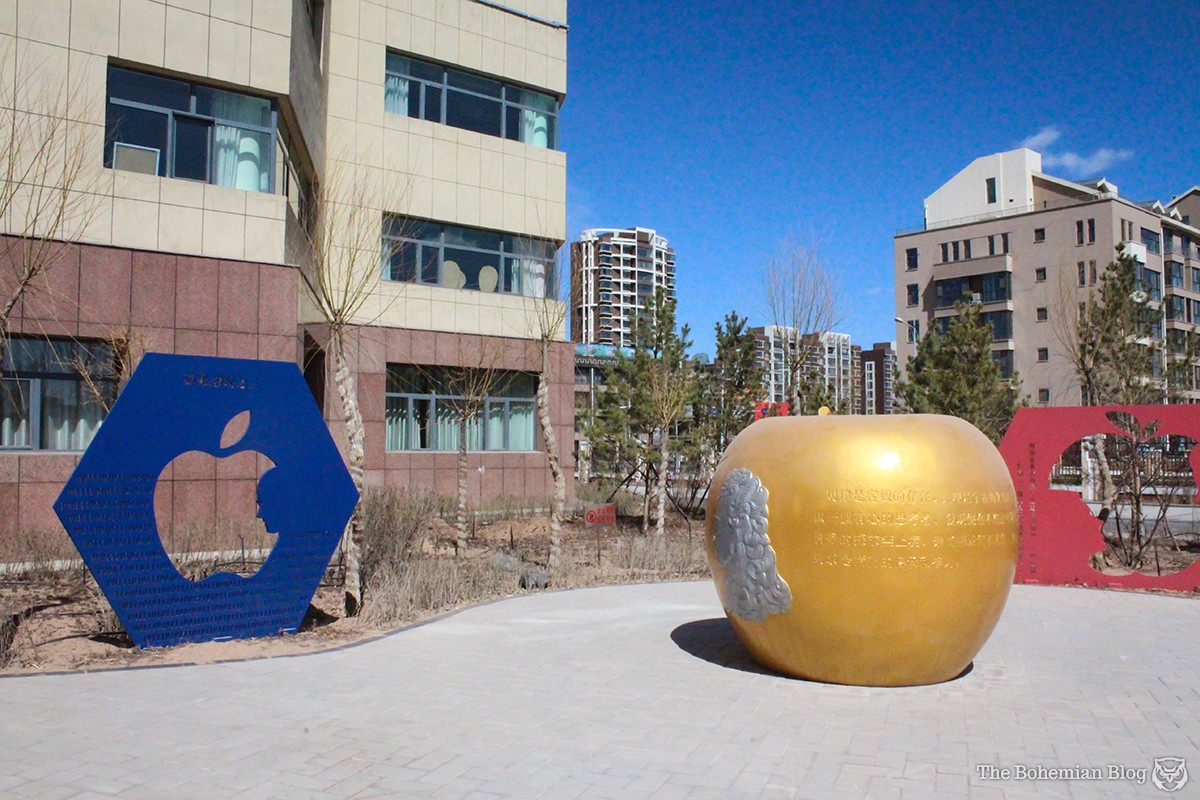
A series of colourful sculptures had been placed in one corner of the yard, apparently united by the theme of apples. Isaac Newton’s face appeared engraved on one giant, metal fruit – another installation bore the familiar profile of Steve Jobs.
“Ten thousand Quai!” laughed our guide. He seemed to find the concept of Kangbashi hilarious; although judging from his clean-cut appearance, his smart and comfortable clothes, the ghost town nevertheless kept its workers in decent money.
The man led us through a courtyard, around the back of the school buildings, and suddenly there it was: the yard opened up into a wide, grassy playing field, flanked on one side by raised seating.
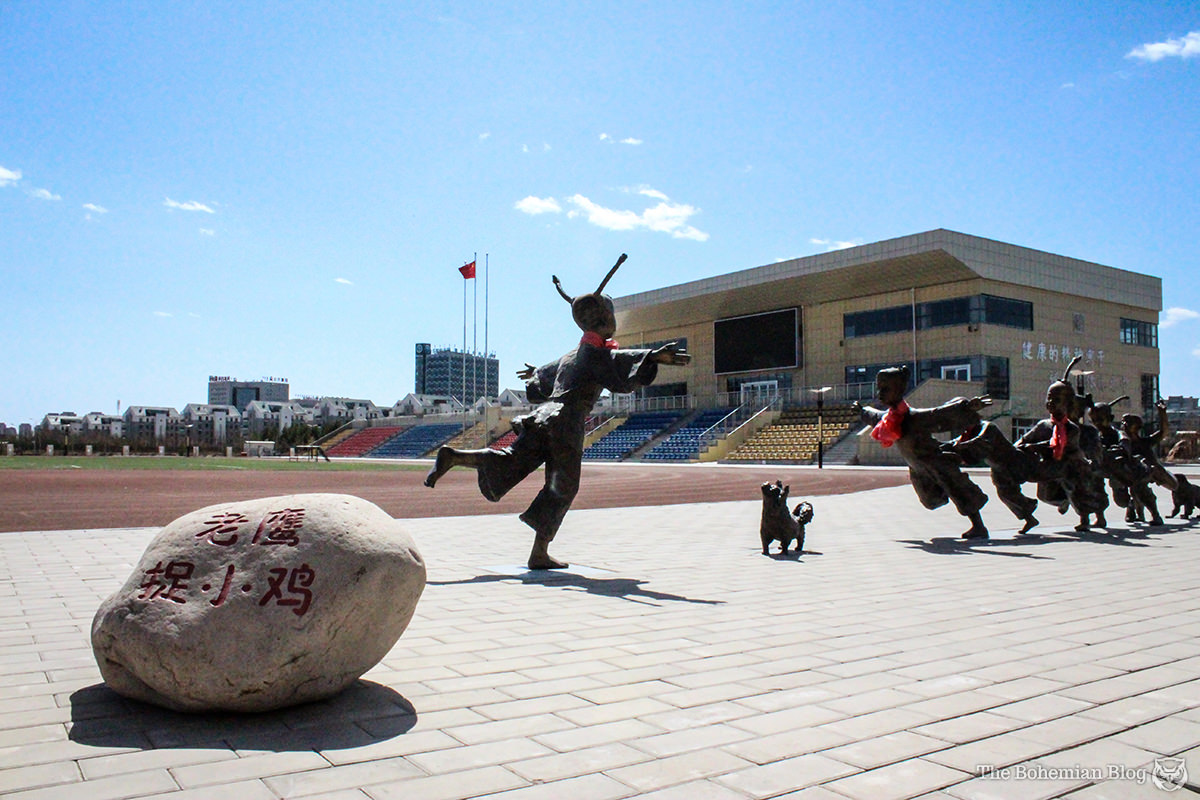
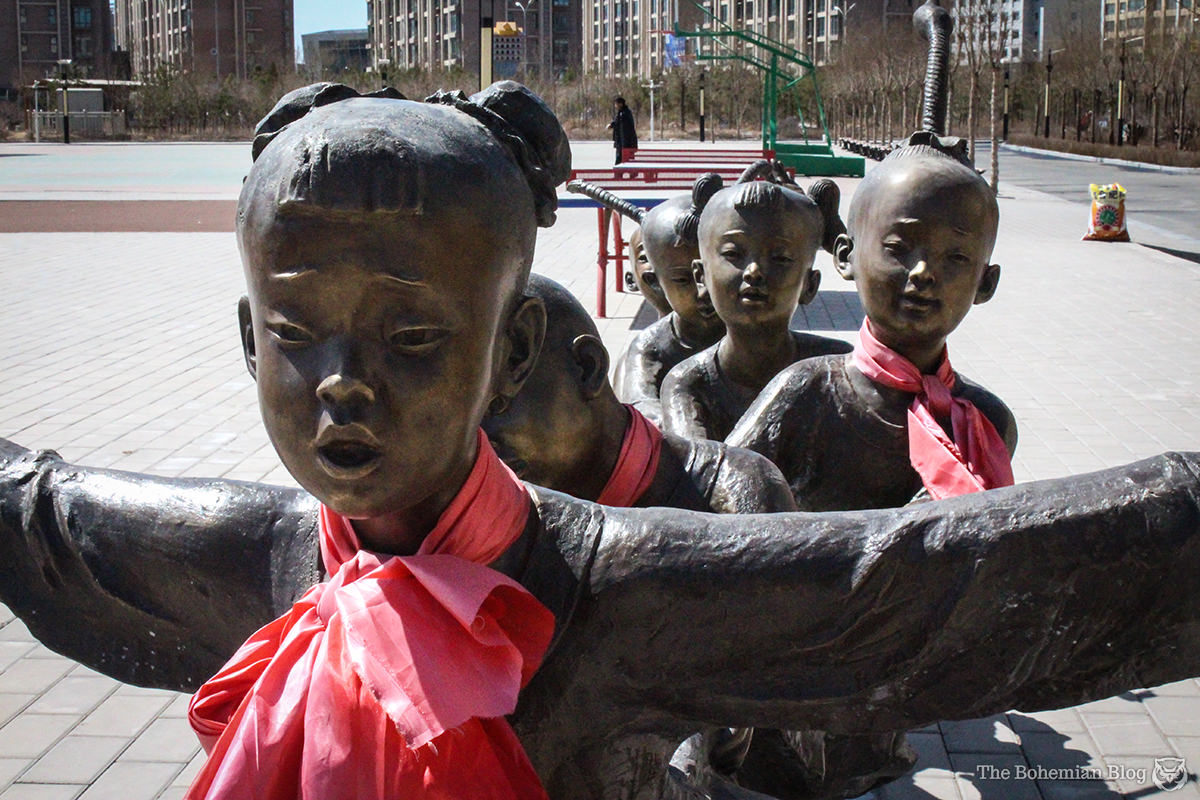
On the edge of the grass pitch – regularly mowed, yet never used – we were pointed towards a series of bronze statues. The figures showed children in traditional Chinese dress, frozen in play as the pink silk scarves tied about their necks flapped noisily in the wind.
“Fifty thousand Quai!” the man giggled, ecstatic, before explaining to us that the silk scarves were washed and replaced on a weekly basis.
At this point our guide suddenly bid us farewell, explaining that he had other duties to attend to. He told us to feel welcome though, and invited us to explore the rest of the facilities. We assured him we would, before making our way towards the raised seating and the building underneath.

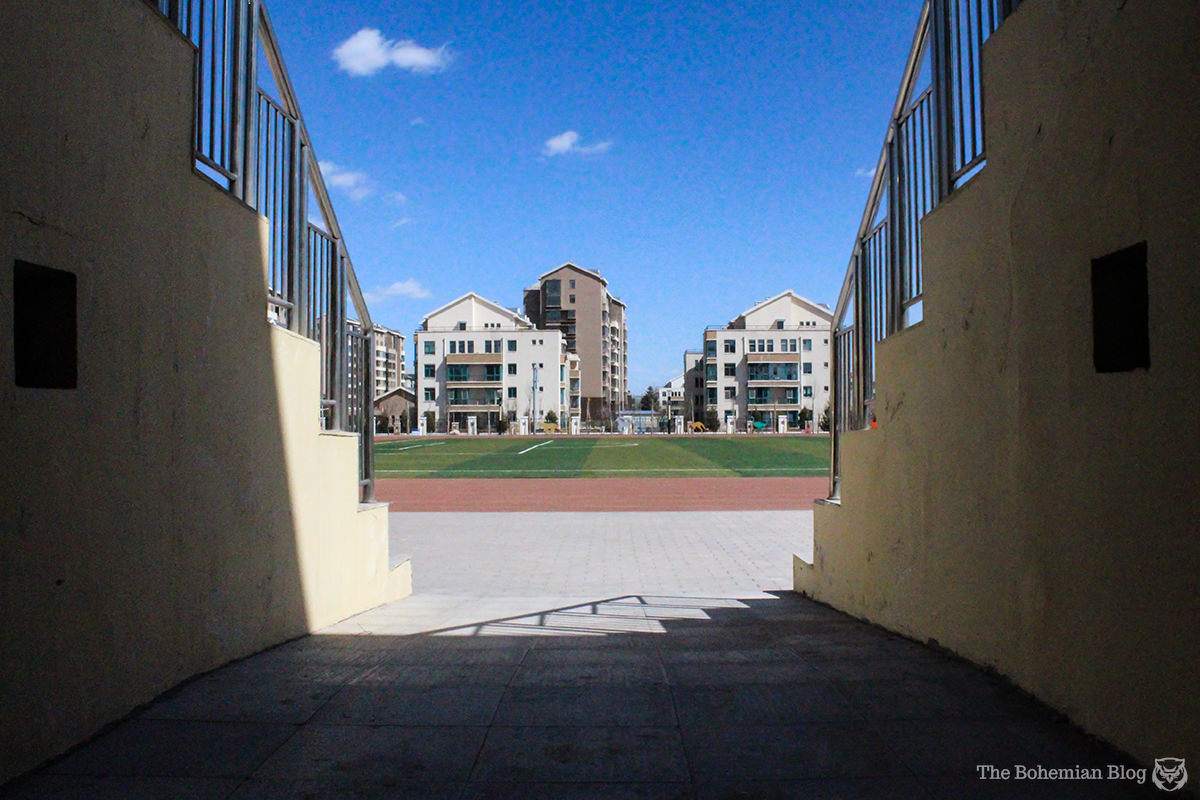
It was a strange feeling to walk past those rows of plastic seats and know that none of them had ever been sat on; past the green grass so neatly marked with white boundary lines and penalty zones, a well-kept pitch which had never yet known a ball.
A passage opened beneath and between the rows, to lead deep within the seating block. We followed it through to a pair of glass doors, marked with a sign reading, ‘Young Pioneers Activity Room’. My friend Gareth, the owner of Young Pioneer Tours, burst into a childish grin as he posed for a photo beneath. Naturally the door was open (we were yet to find a single locked door in Ordos), and so we headed on inside.
The first room we entered, bizarrely, appeared to be a ballet studio. Light filtered in through pink, silken drapes, to cast the mirrored walls and polished floors in an almost supernatural aura of opulence. Next door, a trophy room – shelves lined one wall in miniature cast figurines, their bases left blank and ready for inscription.

We wandered from room to room, admiring the facilities. This was a fully fledged sports centre, ready to open its doors at any moment. One room held a case of basketballs, all brand new and with the smell of freshly formed rubber still clinging to them.
The next was a music studio – a computer sat in one corner was hooked up to a small indoor PA system, complete with microphones and an eight-track mixing desk. Scattered about the various tables lay an assortment of trumpets, drums and guitars.
As we explored, I tried to estimate the total value of the items that lay scattered about the centre: I got into the thousands before I gave up trying. It was simply baffling to think that anyone could have walked in from the street, tried any one of the unlocked doors, and wandered straight inside; exactly as we had done, in fact. The lack of security around the sports centre – around Kangbashi as a whole – was like nothing I had ever seen.


But then, there simply wasn’t anybody on the streets to wander straight inside. Kangbashi is so remote, so isolated, that there seemed to be an general assumption that nobody could be here without a very good reason. After all, why would thieves and vandals travel to an empty city in the Ordos Desert?
 After the sports ground we headed north, past unfinished statues, their scaffold still attached, into a hidden courtyard where a vast monument reared up above us: a silver globe, adorned by a suspiciously Soviet-esque star. Eventually we emerged onto a main road, reaching the space-age silver domes of the Kangbashi Exhibition Centre.
After the sports ground we headed north, past unfinished statues, their scaffold still attached, into a hidden courtyard where a vast monument reared up above us: a silver globe, adorned by a suspiciously Soviet-esque star. Eventually we emerged onto a main road, reaching the space-age silver domes of the Kangbashi Exhibition Centre.
Taking a quick look inside, we stumbled across locals engaged in fierce pingpong tournaments. I picked up a brochure which touted Ordos as the ‘Brave City of The Future’.
Our last stop was a restaurant: we’d been walking for a full day, and it was time to refuel. A sign near the exhibition centre pointed towards a fast food restaurant and we followed it to a seemingly unfinished building, whose automatic doors nevertheless sprung open at our approach.
We walked inside to be met by silence. The place was set up ready for service, tables laid and lights burning bright… but there was nobody to be seen. Gareth inspected the menu as I ducked behind the bar, checking out the wide range of beverages on offer. Amusing as it was to entertain the notion of a free bar, we were both painfully hungry – and so we resolved to try another floor.
The lift took us up one level, to an open-plan office: desks and computers, water coolers and potted plants, but not a sign of life. We had almost given up by the time we reached the third floor. The lift doors opened in silence, and then suddenly we were being welcomed in by a team of uniformed staff. I found myself wondering how long they had stood on ceremony, waiting like automatons for a customer to arrive.
As we waited for our noodles – and after that, the flight back to Beijing – we reflected on our time in the Ghost City.

Over the course of our 24 hours in Ordos, we had tried every door within reach – and not one of them had been locked. We’d seen virtually no one out of uniform, and no sign whatsoever of the authorities. Even the few security guards we’d met had been so surprised at the appearance of foreigners, as to have more or less forgotten their duties. The homes and facilities, meanwhile, ranged from concrete shells to sheer luxury; and yet, in all that time we saw nothing with the appearance of having been lived in.
The thing that really got me thinking though, was the sheer size of the city. If the freedom we’d experienced was anything to go by, it would take weeks – months, even – to explore the whole metropolis. Our day had been spent on rooftops, in office buildings and sports halls… but had we simply picked another direction, it could just as easily have been factories, colleges or law courts; churches, mosques, prisons, pools, shopping centres or train depots.
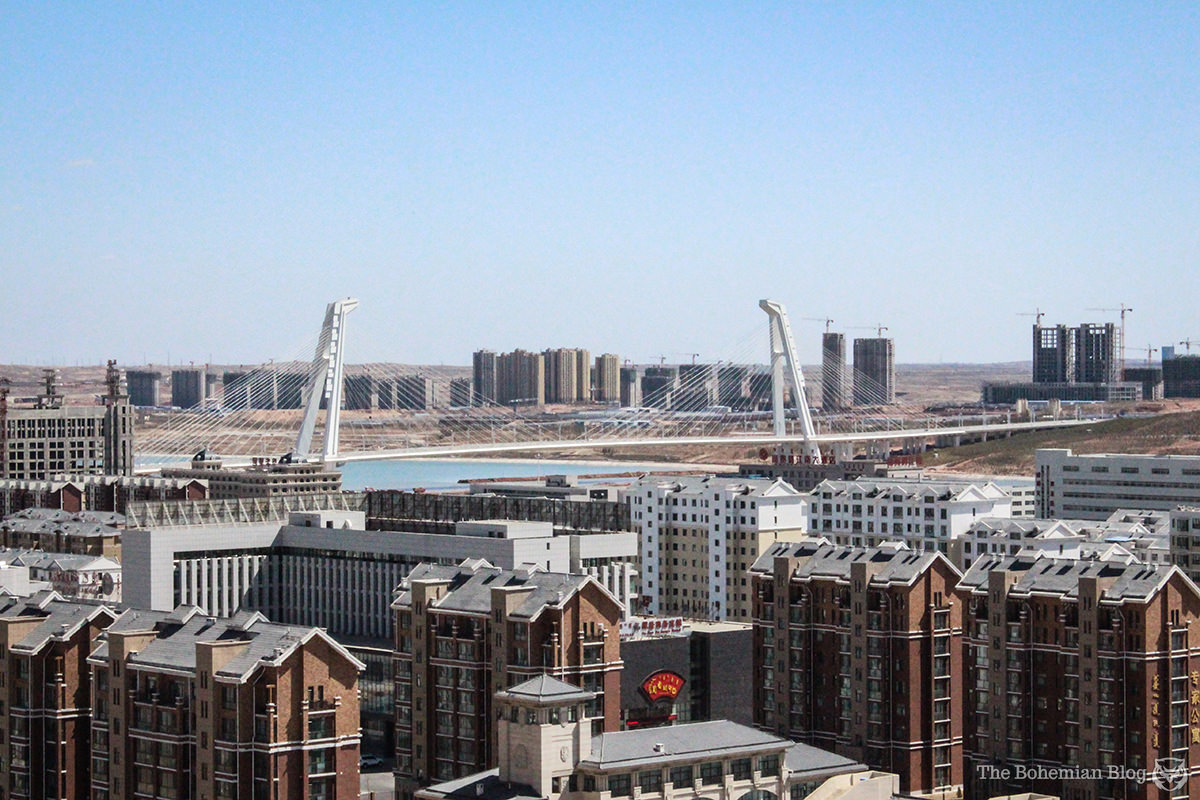

I’ve been to ghost towns before, and large ones at that – just last September I took a tour of Pripyat, for example, in Ukraine’s Chernobyl Exclusion Zone. Kangbashi is like nothing else, however. While perhaps this unfinished city is less elegant, less historical, less tragic, less decayed or moreover less photogenic than sites such as Pripyat, the sense of freedom it offers is unique.
While I’m interested in every aspect of urban exploration, for me, the emphasis has always been on the exploration part… and not only is Ordos 200 times larger than the infamous city of Pripyat, but it is virtually unknown to foreigners. For an urban explorer then, Ordos is a vast, alien playground that offers nothing but discovery.
Suffice to say, I can see myself visiting Ordos again.




Comments are closed.
See all 93 comments on “Getting Under the Skin of Kangbashi: China’s Ghost City”

An illustrated guide to urban exploration in the Russian capital.

Poltergeists, ritual murder & a live-in succubus – the 1000-year-old pub with a ghostly reputation

A month-long monument hunt, and what I learned along the way.
Now it is 2021. What do you thing has changed? Will you go again?
Mate, you should go back with a drone… Excellent stuff.
Very impressive. Thanks and best regards, Manostaxx
Thank you, Manuel!
Why have ppl left the place? I dont read any ghost stories or reasons why they would leave such a quiet place.
They didn’t leave… most of them just never arrived. A lot of the city is still under construction!
When was this article made?
Hi Dioanna, I posted this in February 2014… based on a trip I made the previous summer.
Informative and beautifully mystical at the same time..
Thank you, Suvankar.
Utterly fascinating. Glad I googled and found your real post rather than settling for the clickbait that caught my eye.
I’m glad you did too. 🙂 Thanks for reading!
I love your work. This post was most fascinating. Loved it! Thank you for sharing your travels with the world. Pam.
Thank you so much, Pam – I really appreciate the kind words! Glad you found this post interesting.
I think you gave me the most off-beat reason to head to China. It’s overwhelming looking at your photos and calculating the manpower/materials/management used to construct this place; as a matter of fact it started to make my head hurt when I realized how much detail work was done.
I agree. This has made me want to travel there also.
My heart was in my stomach reading entry after entry explaining the hard work left abandon.
This article will forever be on my mind.
Thanks a lot, Jerry – I found the place quite moving too, so I’m really glad that I managed to convey that same effect on readers.
Yes, it’s absolutely mind-boggling. A phenomenal effort, for what was – at best – a gamble. You should definitely head over there if you get the chance. Pictures and words simply don’t compare to the experience of being there.
Amazing article! Just want to thank you for writing this up!
You’re very welcome, Nando. Thanks for checking it out.
Very fascinating article! This would be a very cool place to visit for a while. It would be interesting to go by the really tall buildings (I believe you mentioned 40-50 stories tall? Or I read elsewhere) and take some pictures. Get an even better idea (picture wise) how big the city is. Anyway, great job!
Yes, some of them were up to 40-or-so levels. Massive things. I’d love to go back and do a follow-up piece – glad you enjoyed this one, though!
I see the city and its surroundings and consider its location and I cannot help but wonder if China is secretly (or not so) expecting to be the last habitable place on earth …… Far fetched I know… It just looks like they are building lifeboats for the human race…. Perhaps I am being too influenced by science fiction…. think Zardoz meets Logans Run meets The Matrix and Blade Runner
Makes you wonder, doesn’t it? The only thing that puts me off the idea is seeing the chaos on the ground – many of these buildings looked as though designed for a quick sale, not built to withstand long years in the desert landscape. But then, there could be a whole extra level beneath the place for all we know.
Really interesting story and photos!! Exactly when were you there?
Thanks a lot, Jack! This visit was back in the Spring of 2013. I’ve heard the place has changed quite a bit since then.
Excellent photos and commentary. Too bad you couldn’t have spent a week or two exploring Ordos more completely, it would have been fun to see more of this ghost city. Thanks for the considerable effort and expense you invested in producing this great photojournalistic tour.
Thank you, Bob. I’m really glad the efforts were appreciated – and as you say, it would be fascinating to get back there for a longer stay. Another time, I’d love to put more effort into meeting the residents and trying to understand what it would be like to actually live there.
Anyway, thanks for reading.
You should definitely come visit Ordos Kangbashi again. You wouldn’t believe the change. We have lived here for just over a year and will be here a while longer. It is now busy and bustling and many of the empty and unfinished buildings are being completed and filling up and new construction is starting. The difference between June 2014 and June 2015 is incredible. Many new people moving here to get away from the busy, polluted big cities. The Ghosts are pretty much gone and we have thoroughly enjoyed our time in this beautiful city.
Hi Cindy, thanks a lot for sharing this! Really interesting to hear about the difference… and yes, I absolutely need to come back and pay another visit sometime. Thanks for commenting.
Excellent writing and observation! I spent six weeks in Ordos in 2012, helping stage the TV coverage of Miss World, which the Ordos local government had ‘bought’ to the region. The stadium was vast, unfinished and without running water: just the thing for 116 beautiful women. The strangest thing is that no one believes you when you speak of the empty skyscrapers, empty shopping malls and empty restaurants! I, too, would love to go back in 10 years to see what has become of Ordos. Ian Hamilton
Six weeks? I bet that must have been fascinating! My main regret was that I didn’t spend longer there. That stadium sounds about right for Ordos too, based on what I saw of the place. I’d really love to go back.
Anyway, thanks for sharing that and I’m happy to hear that some of it rang true for you!
They are just repeating our (American) mistakes. Hopefully we will a learn. Hopefully.
Only time will tell, I guess…
By total coincidence I’m going there on Wednesday! I’m visiting a factory on Thursday that I do business with that happens to be a few hours from the city. I will definitely be spending an afternoon exploring. I’m buying an electric long board day before so I’m going to skate the empty streets of Ordos! Seems like a good place to get to know my new board.
Thanks for the info. I hope the fact I don’t speak Mandarin isn’t too much of an issue.
Alex
Hi Alex, really glad this was useful! Taking the longboard there sounds like an incredible way to explore… I think I suggested cycling in the article, as a way to cover more ground. You’ve just taken it to the next level, though. If you take any photos (or even better, video), please do stop by and share a link on here! I’d truly love to see that.
As with everywhere else in China, language doesn’t seem to matter too much as long as you keep pointing and smiling, and don’t mind making a total fool of yourself. The people in Ordos generally seemed pretty happy about meeting foreigners.
Have fun!
Because of your report sir, I am moving to kangbashi as soon as the money fits the trip. Your review of the city made me feel like it was a place where anything was possible. I cant wait to go.
Tyler, that’s incredible. I can’t say I’m not insanely jealous. I was there for such a short time, and I’d love to know what Kangbashi felt like over an extended stay… do you have anywhere that you share writing and/or pictures? I’d love to follow updates from your new life in Kangbashi. Drop me a link here, if you can.
thanks for the post it really good and liked it, well post,,
You’re welcome, Carl – glad you appreciated it.
Hi, I really enjoyed this article! My girlfriend has a government job in Ordos (yes there is a functioning government there).
She never said what her job is, but all she does is sit in a room with a computer all day. Mind-numbingly dull!
She tells me the city is the size of half a province! I find that hard to believe but she has offered to act as my guide if I want to explore it.
How interesting! Well, you should definitely take her up on that offer. I think it would be fascinating to see the place from an administrative angle, too… on my trip I was mostly just amazed at all the empty stuff. If I ever go again though, I’d love to get to know more about the people who do actually live there, and look at this from the perspective of an unusual – but fully functional – community.
Thank you for sharing. Like you, I am also somewhat drawn to the dark and fascinating aspects of travel and tourism, but a lone female photojournalist like me in an alien location is more fraught with risks. So keep safe in your travels and share more. 🙂
Thank you! Do you have a site for your own photos? I’d be interested to see them.
this has been a great story to read and the first one was as well, i envy the freedom you had in such a large place, iv always wondered what a city would be without people, and now i feel i have a better understanding, i said i would never go to a city for vacation, but ordos has made my list. thanks for documenting such a wild place, but i do wish the money spent there could have gone to alot better cause’s kinda sad but you cant win them all
Hi Michael, thanks for commenting. I completely agree with you – there are plenty of better causes that this money could have been spent on! Nevertheless, it makes for a fascinating place to explore. Like you, I’m really interested by the idea of cities devoid of people, and Ordos offered that experience on a scale I had never before imagined! If you’re looking for an unconventional city break, well, this one is pretty unique…
Being involved in civil engineering and construction, I still can’t even omprehend the amount of money that was spend to plan, design, and build this amazing city. We are talking about billion and billions of dollars that were spent. Then to think that it is, by most means, being wasted by simply standing there, lifeless. It is hard to grasp this reality, especially when one visits other places where people would give anything to simply have a place to live and/or give them shelter. If those billions and billions of dollars were spent in some other way, say research, important infrastructure projects, schools, etc, it could have had the opportunity to change the world. But for now it is all an area were exploring junkies like us can go and get their fix of weird adventures and awesome sites.
Hi Joaquin, thanks for commenting – it’s really interesting to hear from someone with your background.
I couldn’t even begin to put a price on this construction project, it’s hard to imagine just how much time and money has gone into creating the empty city. And like you say, if the money had gone into some other cause instead – medical research, for instance – the amount of benefit it might have had is almost limitless. So while the “exploring junkie” in me had a great time visiting, and walking through this bizarre place, don’t worry – the very real tragedy of these wasted funds is not lost on me.
Excellent article! You get into so many places and cover so much. You describe the area perfectly. It’s exactly how you tell. I just visited Ordos last week. You definitely need a few days to explore this area. A bike would have been nice. We only spent the day there and were pooped by the end of the day.
My recommendation to people who visit independently is to stay in Dongsheng and catch the local bus in. Between Ordos and Dongsheng are some interesting places, like a half finished stadium and an industrial parks. Dongsheng’s a strange place too with some classic duplicated apartment blocks and lots of unfinished projects.
Thanks for the article! Inspired my trip!
Thank you, Kynan. It’s always interesting to compare notes with someone else who has been there…
A bike is a very good idea! And definitely more time – my own visit felt very rushed, there was a lot more I would have liked to have seen and done in the city. Maybe next time…
Anyway, I’m glad to hear you enjoyed your own trip, and I’m happy to have been able to help!
Very good piece here Darmon. It reminds of a story from the Martian Chronicles except for public servants instead of robots in place to take care of an empty city. So ironic considering that cities like Shanghai and Beijing are ridiculously overcrowded but yet here stands a ghost city that likely may never be filled.
Having traveled to China a number of times I can understand ‘why’ the urban developers would consider starting a city like this from scratch. So many of the cities in China are desperately trying to build new infrastructure on top of centuries old urban areas. I can see them figuring it would be better to just start fresh and not have to rebuild. I guess the planners simply thought ‘if we build it, they will come.’ Shame too from the photos the city itself looks nice.
I’ve never gotten around to reading The Martian Chronicles! Might have to go dig out some Bradbury now… love your metaphor.It’s not like this plan hasn’t worked in other places, of course. China is always popping new cities up out of the ground, then there are successful new-build cities like Astana, in neighbouring Kazakhstan.I guess this time it was an oversight. The prices were too high, it’s too far away from anything. And yeah, real shame – the place is beautiful, really great example of 21st century urban planning.
I’m always fascinated to see photos of Ordos, top job mate. Have you seen that video a couple of skaters made there? Absolutely fantastic!
The Red Bull one? Yeah, that was amazing!
Thanks so much for this. I seriously want to move there. Do you know if foreigners can buy a condo there?
As far as I know, they can. There are brochures in some of the hotels and the exhibition centre, advertising the potential for property investment in Kangbashi. I’d imagine it’s no harder than it would be to buy an apartment anywhere else in China. I’m sort of considering it myself…
You still didn’t uncover the face of Kangbashi which you had wanted to initially. Your report is largely a descriptive one of the physical features of Kangbashi, you didn’t really dig deeper as to how such a big city could have been so abandoned.
Hi Emily, thanks for the comment… I feel you’re inserting your own meaning into my words, though. I said I wanted to “dig deeper,” and I feel I did exactly that; given that my goal was always to investigate the physicality of the place. It’s far from an exhaustive report, of course, in no small part due to the vast size of the place in question.
You seem to interpret “digging deeper” differently though, as offering more of a socio-economic explanation for the state of this city. If you do find an account that satisfies your definition, I’d be grateful if you could post a link here. While that really isn’t my field (remember I’m a travel writer, not an economist), I’d still be fascinated to read it.
I traveled to Kangbashi on a research grant through my university, and these photos truly capture the feeling of many areas of the district. They’re beautiful, and they make me wish I’d spent more time chancing arrest just to see more. However, my experience of the emptiness of Kangbashi was slightly different. I spent a week exploring in early August last summer and was actually surprised by the amount of company I had. This led me to question several of the student workers in the museum and library about traffic, and they reported that they see several hundred people a day–over tourist season. Kangbashi is certainly selling itself as a destination spot amongst the growing Chinese tourism industry, and I believe that this is where the future of the city is really headed (having spent enough time in Beijing, I’d certainly make the trip for a few days of peace, quiet and clean air in Ordos).
Did you have a chance to pick up a palace-shaped brochure, filled with upcoming attractions? It’s really fascinating. If you do choose to visit again I’d recommend that you stay in Dongsheng and commute to Kangbashi if only to compare the atmosphere and see the number of full buses going back and forth every twenty minutes.
Thank you Bailey, I’m really flattered by your kind words! Particularly coming from someone who has seen Kangbashi with their own eyes.
As for “chancing arrest,” I really don’t know – I mean, I didn’t see police in all the time I was there, and mostly I just got the impression that nobody cared what we were doing.
Whereabouts in the city were you? I saw there were some busy restaurants and cafes in old Ordos, as well as some in the centre of Kangbashi. The museum also, seemed to have a fairly constant stream of people coming in and out.
Personally, I was interested in finding the empty parts. It wasn’t hard, either – just a short walk into the unfinished suburbs of Kangbashi, and we were soon completely alone.
I did pick up the brochure, yes… and I mentioned in the first part of this report the plaque that described Ordos as the “Outstanding tourism city of China”, or something like that. Just weird.
I would be very interested in returning sometime in the future, and perhaps doing what you did – instead of focussing on the empty districts, spending more time talking to the people who are there, and finding out more about the small yet fascinating culture of the city.
Thanks again for an interesting comment! Always good to hear an alternate perspective.
I’ve been trying to get a clear picture on Kangbashi and now I have! This article conveys a lot of the atmosphere, I think.
Good – that was my main goal here. Thanks for the comment!
Hey! Fantastic article – thanks!
Was thinking if you know about any academic literature on this phenomenon – either case studies like yours or anything general on “ghost cities” as such.
If you come up with something, it’ll be well appreciated 😉
Ondra
Thank you Ondra! Glad you enjoyed the article. There are a few good explanations that I’ve read, for how this phenomenon comes about. Try looking for the articles by TIME or the BBC.
There are also a few interesting documentaries on the subject:
here and here, for example.
Fantastic article. I read this with awe in the sense of investment lost in building such a large city on speculation alone. It would be interesting to see aerial photography of the area to get a good idea of the overall size. I can only imagine the look of surprise you faced with inhabitants when you ran into them. Just amazing! Thanks for your efforts!
Thanks for the kind words, Chris – and yes, it looks crazy from above. Go and check Ordos out on Google Maps, and you’ll see just how vast these unfinished regions of the city really are.
Your excellent visual tour reminds me of Percy Shelley’s poem “Ozymandias”: http://en.wikipedia.org/wiki/Ozymandias
Nicely done, I feel like I have been there and share in the sense of wonder you experienced.
…Round the decay
Of that colossal wreck, boundless and bare
The lone and level sands stretch far away.
Yes, I think I can see where you’re going with that comparison. Thanks for the insightful comment, and I’m glad you enjoyed the tour.
Fascinating. Makes me wonder how fun it would be to bring a motorcycle or bicycle there to be more mobile, you could ride it anywhere…
You’re absolutely right, that would be the way to do it. Next time…!
So strange! Where do the workers live? There must be a whole underground society that feeds, shelters and entertains the working class. Reminds me of that Will Smith movie “I am Legend”! Let’s hope there are no strange genetically mutated monsters waiting in the underground parking garages.
I’m happy to say that I certainly didn’t run into any genetically mutated monsters during my visit.
I believe most of the workers live in Old Ordos, along with the vast crew of people who provide them with entertainment, food, accommodation, and so on.
Fascinating read! Pulling Ordus up on Google Maps reveals the totally massive scale that you eluded to – it’s staggering. For example there appear to be multiple completed sports stadiums – all appear to have similar very well manicured pitches…. The interesting thing is that there does appear to be small pockets of habitation with a few buildings appearing to have at least a decent # of cars parked next to them. Areas to explore during your next visit!…
Thank you, David. There were quite a few sports grounds and stadiums around the city, the one we visited was simply the easiest to reach. I’m amazed by the level of maintenance that must go into keeping the place in this condition, with so much of the city ready to burst into life at any moment.
As I mentioned, the old centre of Ordos is quite well populated. So as you say, having written this report, it would be very interesting to go back again and focus instead on the life and culture of those inhabited areas.
Perfect post apocalyptic movie setting – the film industry should be interested…
I know… if they fail to recoup their investments any other way, the developers should be seriously thinking about talks with Hollywood.
I read about this ghost city before, but nowhere in such depth, up close and personal.
Great Job!
Thank you for both articles (This one and part 1)!
Thanks Abe! There have been quite a few articles written about this place in the past, but like you say, none of them in much depth… hence my inspiration for visiting. Thanks for reading and commenting!
Great photos! Wish we had read it before writing about it recently. Could have used some of this info.
Well, if you decide to write anything about it again in future, let me know! Glad you enjoyed the photos.
Truly incredible report. Thanks so much!
You’re very welcome Andy, thanks for the kind words.
What a truly bizarre, place. You’ve nicely captured the eerie atmosphere of the deserted city. Another top post.
Thank you, Dale. Like I said in the post, what I saw was just one tiny fraction of the city – and I navigated the whole thing more or less at random. It’s amazing to think how differently the report could have turned out, if I’d walked in the opposite direction… definitely a place to revisit sometime!
Great Blog. Thoroughly enjoyed reading your eloquent descriptions and looking at your wonderful photos. Keep up the good work!
Thanks a lot for the kind words! Really appreciate the feedback.
wow thoroughly enjoyed reading that, Fascinating yet bizarre, would be awesome to check out.
Thanks Craig, it really is a weird place. If you ever fancy it, I do highly recommend a visit to Kangbashi.
Funnily enough, while a lot of the places I write about are trying to keep people out, this one will be positively glad to see you!
Oh how I would love to explore there also. But age and distance say no. I really appreciate your work.
Thank you. One of the reasons I prefer to write long-form pieces like this, is to give as full a sense of the experience as possible – I appreciate not everyone has the time to get to these places for themselves. Glad to hear you’re enjoying the results!